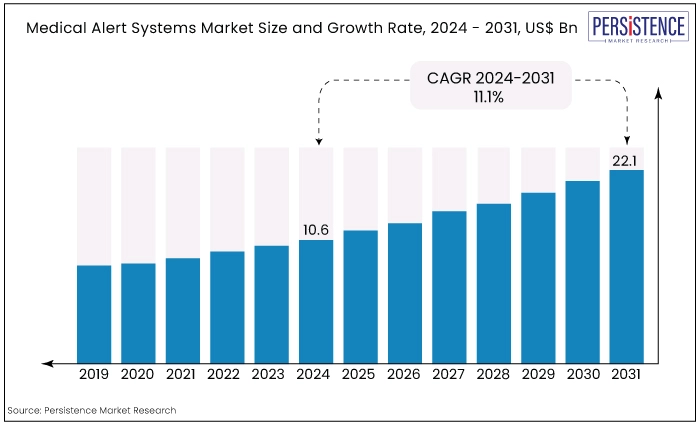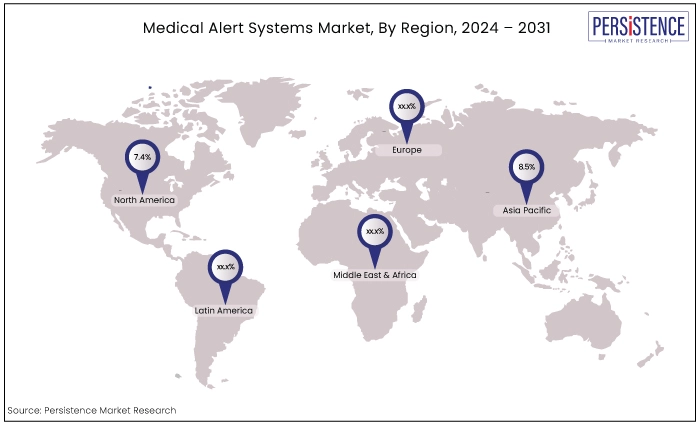Industry: Healthcare
Published Date: July-2024
Format: PPT*, PDF, EXCEL
Delivery Timelines: Contact Sales
Number of Pages: 187
Report ID: PMRREP34704
The global medical alert systems market is estimated to value at US$22.1 Bn by the end of 2031 from US$10.6 Bn recorded in 2024. the market is expected to secure a CAGR of 11.1% in the forthcoming years from 2024 to 2031.
Key Highlights of the Market
|
Market Attributes |
Key Insights |
|
Medical Alert Systems Market Size (2024E) |
US$10.6 Bn |
|
Projected Market Value (2031F) |
US$22.1 Bn |
|
Forecast Growth Rate (CAGR 2024 to 2031) |
11.1% |
|
Historical Growth Rate (CAGR 2018 to 2023) |
10.7% |

The medical alert systems industry is undergoing significant transformation with the introduction of advanced technologies, and innovative practices aimed at improving safety and efficiency.
The market encompasses devices and services designed to enhance personal safety and health monitoring, particularly for individuals at high risk of medical emergencies. These systems, also known as Personal Emergency Response Systems (PERS), provide users with a reliable way to connect to emergency services quickly.
The market includes various types of devices such as in-home systems, which typically feature a base station and wearable pendants, and mobile systems, which use cellular networks and GPS technology for coverage both inside and outside the home.
With the rising global elderly population, increasing chronic disease prevalence, and advancements in technology, the demand is growing.
Key market drivers include the need for improved safety for seniors living alone, technological innovations such as smart home integration and automatic fall detection, and greater awareness of personal health management.
However, the market also faces challenges such as stigma and high costs, which can impact adoption rates. Overall, the market is poised for growth as it evolves to meet the needs of an aging population and embraces new technological advancements.
Over the past decade, the medical alert systems has experienced consistent growth, fueled by several significant factors. The rising global elderly population, particularly those living alone, has substantially increased the demand for these systems.
Technological advancements have also played a crucial role, with innovations such as sophisticated wearables and smart home integrations enhancing the functionality and attractiveness.
Additionally, the growing prevalence of chronic diseases like diabetes and heart disease has heightened the need for effective monitoring and emergency response solutions.
Increased awareness about the benefits of medical alert systems, driven by educational initiatives and awareness campaigns, has further boosted adoption rates. Market expansion into regions like North America, Europe, and emerging markets in Asia Pacific, and Latin America has also contributed to this growth.
The market is poised for continued expansion, driven by emerging trends and opportunities. Integration with smart home technologies and voice assistants is expected to offer enhanced features and a more seamless user experience.
Advances in wearable technology, including improved health monitoring and automatic fall detection, will further propel market growth. The integration with telehealth services and enhanced connectivity options, such as 5G, will provide more comprehensive support and real-time monitoring.
There will also be a greater focus on personalized and customizable solutions to cater to individual health needs and preferences. Additionally, continued expansion into emerging markets will present significant growth opportunities as these regions see rising elderly populations and increased healthcare investments.
Evolving regulations and policies will shape market dynamics, potentially impacting product development and market entry. Overall, the medical alert systems market is set to grow steadily, supported by technological advancements, demographic shifts, and increasing global demand.
Chronic Disease Surge Fuels Growth in Demand
The escalating prevalence of chronic diseases such as diabetes, heart disease, stroke, and cancers, significantly drives the market expansion.
As individuals live longer, the burden of managing these conditions intensifies, with approximately one in three adults globally suffering from multiple chronic conditions (MCCs). This transition from infectious to noncommunicable diseases has led to an estimated global cost of $47 trillion by 2030.
Chronic diseases necessitate continuous monitoring and timely medical intervention, which these systems adeptly provide. These systems offer immediate access to emergency services, essential for managing the frequent complications associated with MCCs.
With healthcare expenditures rising exponentially with each additional chronic condition, medical alert systems also help mitigate emergency department presentations and hospital admissions by ensuring prompt medical response. As the incidence and economic impact of chronic diseases grow, the demand for reliable systems is poised to increase substantially.
Growing Recognition and Adoption Rate
The growing awareness and adoption significantly drive market expansion. As the global population ages and the prevalence of chronic diseases rises, individuals and caregivers increasingly recognize the importance of these systems.
Over 30% of people over 65 experience falls annually, with nearly half suffering recurrent falls, underscoring the need for immediate medical assistance.
Educational campaigns and healthcare provider recommendations have heightened public awareness of the benefits these systems offer, such as quick access to emergency services and enhanced safety for elderly and chronically ill individuals.
The integration of advanced features like GPS tracking, automatic fall detection, and mobile connectivity has further bolstered adoption rates, making these systems more attractive and user-friendly. The growing recognition of the critical role medical alert systems play in ensuring safety and timely medical response is propelling the market ahead.
Addressing Stigma and Reluctance
Despite the evident benefits of medical alert systems, stigma and reluctance remain significant barriers to market growth. Many potential users, particularly older adults, perceive these devices as symbols of frailty and dependence. This stigma discourages adoption, even among those who could greatly benefit from such systems.
Research indicates that falls are a major concern for over 30% of individuals over 65, yet many are hesitant to use medical alert systems due to the associated negative connotations.
This reluctance is compounded by a preference for maintaining independence and fear of admitting vulnerability. Additionally, some users dislike wearing the devices, viewing them as cumbersome or unattractive.
To overcome these barriers, manufacturers need to focus on designing discreet, fashionable, and user-friendly devices, along with educational campaigns to shift perceptions. Addressing the stigma and reluctance associated with medical alert systems is crucial for unlocking their full market potential and enhancing user safety.
Expansion in Developing Markets
Emerging markets offer significant growth opportunities for the market. With an aging population and increasing prevalence of chronic diseases in countries like China, India, and Brazil, the demand for reliable medical alert solutions is on the rise.
For example, China’s elderly population (aged 65 and above) is projected to reach 370 million by 2050, up from 150 million in 2018.
The expansion of healthcare infrastructure and increased awareness of elder care in these regions further supports market growth. Additionally, technological advancements and increasing smartphone penetration make mobile medical alert systems more accessible.
The affordability and adaptability of these systems to various socioeconomic conditions provide a competitive edge in these markets.
Companies focusing on these emerging markets can capitalize on the growing demand by offering cost-effective, user-friendly solutions tailored to local needs. This strategic expansion can drive significant market growth and improve safety and healthcare outcomes for millions of elderly individuals globally.
Increasing Integration with Smart Home Technologies
The integration with smart home technologies offers substantial growth opportunities in the market. For example, integrating medical alert systems with smart home devices like Amazon Echo, or Google Nest enables voice-activated emergency assistance, seamless monitoring, and automated alerts.
This integration can improve response times and provide users with additional safety features, such as automatic lighting and door locking during emergencies.
Furthermore, smart home technologies can facilitate continuous health monitoring through connected devices like smartwatches and fitness trackers, providing real-time data to caregivers and medical professionals.
Companies that embrace this integration can offer comprehensive, innovative solutions that appeal to tech-savvy consumers, ultimately driving market growth and improving quality of life for users.
|
Category |
Projected CAGR through 2031 |
|
Type Category - Mobile PERS |
8.1% |
|
End User-Assisted living facilities |
9.3% |
Mobile PERS to be the Leading Segment by Type
The mobile personal emergency response systems (PERS) segment is poised to account for a significant share of the market. Mobile PERS offer a critical advantage: they provide emergency assistance both at home and on-the-go, catering to the increasingly active elderly population.
With the global elderly population (aged 65 and above) expected to reach 1.5 billion by 2050, the demand for versatile, reliable emergency response solutions is rising.
For example, devices like the LifeFone mobile alert system use cellular networks and GPS technology to ensure users can access emergency services anywhere. This flexibility is crucial as more seniors prefer to maintain active lifestyles.
The growing adoption of smartphones and wearable technology further fuels this segment's growth, enabling seamless integration with mobile PERS. As the need for comprehensive, portable emergency response systems continues to grow, the Mobile PERS segment is set to dominate, offering unparalleled convenience and safety for users.
Assisted Living Facilities to Show a Notable Rise in Adoption
The market is expected to see notable growth in the assisted living facilities sector. With the increasing demand for eldercare services and the rising number of seniors opting for assisted living arrangements, these facilities are becoming key adopters of advanced medical alert technologies.
Medical alert systems play a crucial role in this environment by enhancing safety and providing immediate access to emergency services for residents. For instance, facilities are increasingly incorporating systems with features such as automatic fall detection, GPS tracking, and real-time health monitoring to ensure swift responses to medical emergencies.
The integration in assisted living facilities not only improves resident safety but also supports staff efficiency and operational management. As these facilities expand and evolve, the adoption of sophisticated medical alert solutions is expected to grow, driving market expansion in this segment.
|
Region |
CAGR through 2034 |
|
North America |
7.4% |
|
Asia Pacific |
8.5% |
North America to Account for the Significant Share in the Medical Alert Systems Market
North America is set to account for a significant share of the market due to a combination of factors including a high aging population, advanced healthcare infrastructure, and increasing adoption of technology-driven health solutions.
The US, and Canada have substantial elderly populations, with the number of people aged 65 and over projected to exceed 100 million by 2030 in the US alone.
Moreover, the high prevalence of chronic diseases and the demand for enhanced home safety solutions drive the market. For example, in 2024, the US market for medical alert systems is expected to grow significantly, supported by widespread healthcare coverage and rising awareness of the benefits of these systems.
The presence of key market players and ongoing advancements in technology, such as integration with smart home systems and mobile alerts, further bolster North America’s dominance. The region's robust healthcare infrastructure and consumer readiness make it a leading market for medical alert systems.
Asia Pacific to Exhibit Notable CAGR in the Medical Alert Systems Market
The Asia Pacific region is expected to exhibit a notable CAGR in the medical alert systems market. This growth is driven by the rapidly aging population, increasing healthcare expenditure, and growing awareness of advanced healthcare technologies.
With countries like China, and India experiencing substantial demographic shifts, including a rising elderly population, the demand for medical alert systems is intensifying. For instance, China's elderly population is projected to reach 370 million by 2050, creating a significant market opportunity for medical alert solutions.
Additionally, the expansion of healthcare infrastructure and technological advancements are enhancing market prospects. The increasing integration of mobile and smart home technologies in medical alert systems further fuels growth in the region.
As healthcare awareness improves and economic conditions support increased adoption, Asia Pacific is positioned for substantial growth in the medical alert systems market, reflecting its expanding role in global healthcare.

Acquisitions and partnerships, along with the development of innovative products and the expansion of production capacities, are key growth strategies followed by major players in the Medical Alert Systems market.
Recent Industry Developments
|
Attributes |
Details |
|
Forecast Period |
2024 to 2031 |
|
Historical Data Available for |
2018 to 2023 |
|
Market Analysis |
US$ Billion for Value |
|
Key Regions Covered |
|
|
Key Market Segments Covered |
|
|
Key Companies Profiled in the Report |
|
|
Report Coverage |
|
|
Customization & Pricing |
Available upon request |
By Type
By End User
By Region
To know more about delivery timeline for this report Contact Sales

Medical alert systems, also known as personal emergency response systems (PERS), are devices designed to connect users quickly to emergency services in the event of a health crisis.
Key drivers include the rising aging population, increased awareness and adoption, and technological advancements.
Restraints may involve stigma and reluctance to use medical alert systems and high costs associated with advanced features.
Future opportunities in the medical alert systems market include integrating with smart home technologies, expanding into emerging markets, leveraging advancements in wearables and connectivity, offering customizable and mental health-focused solutions, integrating with telehealth.
North America to account for the significant share in the market.